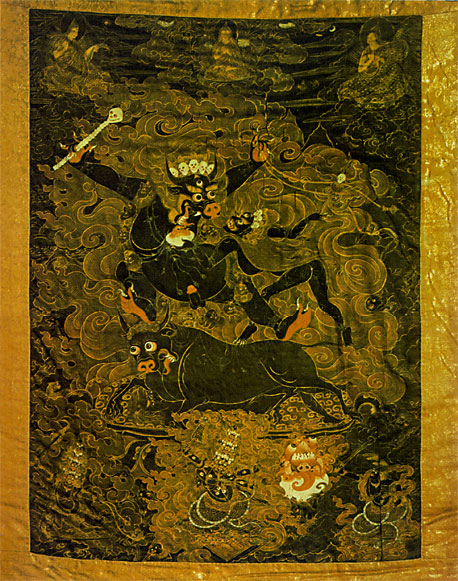| << UbuWeb |
| Aspen no. 10, item 3 |
|
|
| The Yama Tanka |

|
|
Yama, Eighteenth Century Tibet The tradition of the tanka, as the hanging scroll is called in Tibetan, seems from the available texts to have been highly rationalized. Iconography and technique were rooted in the Indian tradition; the hanging scroll idea was clarified by direct contact with China. The tanka is begun with the weaving of cotton threads as the support of the colors. The Hevajra Tantra states that the woman who is to spin the thread and weave the canvas should be of the tradition and united to its sacramental power. After the cloth was woven, it was laced tight to a wooden frame and covered with a ground of very fine white earth mixed with ritual ingredients and an adhesive such as gum. This ground was then carefully polished and burnished. No one seems to record whether this was best done by the artist or his mudra, who, during the inspired time of the actual painting, was to be seated to the left of her master. It was prescribed that the painter and his beloved remove themselves to an isolated outdoor spot for the creation of the painting. The vision in the Yama Tanka of the primal pair as twins, or brother and sister, goes back to Vedic materials. By the time Vajrayana Buddhism got to Tibet, most of the traditional forms had been described verbally from experiences of deep meditative levels of consciousness. In these collections of descriptions of visions (called sadhanas) was also given the seed mantra or sound which, when properly intoned and directed to the proper place in the body, evoked the vision of the form to be painted. The artist-yogin studied previously painted versions of his subject and the descrip tions from the sadhana. He then practised the visualization intently until it became, with practice, more vivid than the external scene. At that point, the artist (i.e., one trained in bringing the vision onto a flat plane) draws in strong fine lines the outline of the vision. When the lines are seen on the surface, the vision in full color from within is made to register on that surface, which is experienced, as the most sacred section of the visual field and simultaneous with the center of the viewer. Macrocosm and microcosm are resolved in the filling in of the colors. The Yama Tanka, now in the collection of the Calcutta Museum, is one of the world's great paintings. Its subject, Yama, minister of the exterior, king of religion, lord of the dead, has the rank of Bodhisattva and is one of the eight Dharmapala of Mahayana. He is accompanied by his sister, Yami (pronounced Yummy). They dance their ecstatic dance on the back of a black bull (bullfight, Picasso, Dionysian rites) who is supported by a supine female figure, who in turn is supported by a lotus which springs up from the endless waters of the mind. In this vision is revealed the intensity of the yogin's striving to overcome all karmic necessity to reincarnate. Yama consumes and destroys the ignorance and darkness of the samsara and is guide and ruler of the after-death states. He is encountered everywhere until one knows and identifies with that which is unchanging and beyond duality. He is assigned to the southern region of the mandala, the region of all the ancestors. Yama is the order of all things in the cosmos and as Dharmaraja establishes the immutability of the supreme principle. Above the head of Yama is Tson K'apa, that incarnation of Manjushri who founded the Yellow Hat sect of Vagrayana in the fifteenth century and who assigned Yama as the protector of his order. Tson K'apa is flanked by two devout followers. Below Yama are the all-seeing Naga or serpent lords, powers of the underworld over which he rules. Surrounding him are the flames which burn away ignorance. Searching in this fire of knowledge, one sees many attendant creatures and notices that Yami offers Yama a skull cup (kapala) filled with blood and brains, symbol of liberation from the ideas of substance and non-substance. Yama wears a garland of freshly severed heads and a tiara of five skulls — his nails unshorn, penis erect. The vision is "seen" beyond the senses, symbolized by the offering of the skull cup filled with organs of the five senses in the painting's lower left. — Allen Atwell ©Aspen No. 10, Section 3 |
|
Original format: Single sheet printed on both sides, 9 by 11 1/4 inches. |
|
|
|
|
|
|
|